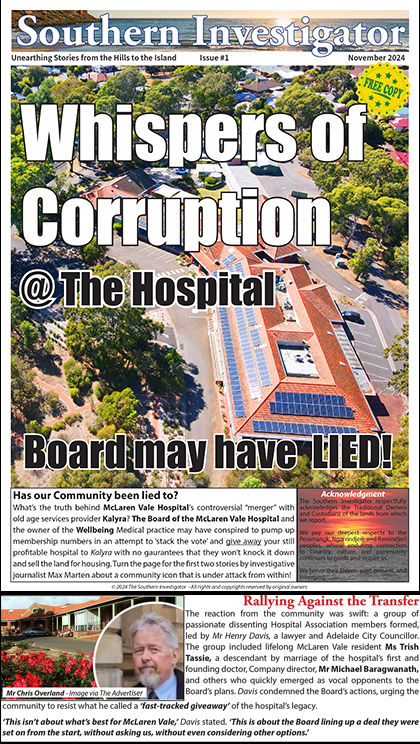Recent Challenges and Legal Battles (2023-2025)

The Road Ahead
A New Form of Health Business
In response to the challenges of recent years, McLaren Vale Hospital has adopted a renewed business model focused on sustainability, community integration, and adaptive service delivery. The model emphasises diversified revenue streams, combining Allied Health Services in Phase 1 and Respite and Palliative inpatient care in Phase 2, with innovative health and wellness programs, as well as the possibility of short-stay rehabilitation and related health services. It also leverages the hospital's heritage buildings and grounds to host educational workshops, creative arts therapy, and community events, fostering deeper engagement with residents.
This hybrid approach positions the hospital not only as a healthcare provider but as a community health hub, capable of generating income while preserving its not-for-profit mission and historical significance.
For the Community
The History Project – Preserving the Past, Inspiring the Future
While some claim they can see the future, we’re pretty sure most cannot. That said, the past absolutely shapes what’s ahead, and for McLaren Vale, our past is powerful. The 2024–2025 court battle hit the hospital association hard—some even wished it would end things entirely. But true to form, the McLaren Vale community rolled up its sleeves and got on with it.
Now, with a refreshed board and renewed purpose, we’re embracing a two-pronged recovery: the new business model outlined above and a deeply human reconnection through The History Project.
The History Project is more than nostalgia; it’s a bold act of healing. It honours 74 years of care, service, and community connection while actively building a cultural and economic future. We're turning unused spaces into vibrant archives, podcast studios, galleries, and walking tours. Local artists, volunteers, historians, and students are joining forces to capture stories before they’re lost. The third generation of founding families is now our living memory; time is running out to capture their voices.
As we preserve the past, we lay the foundation for a future filled with pride, creativity, and shared purpose. Join us in remembering, rebuilding, and rising together.
We can't get the stories of the beginning from the founders, as they're all gone, but they shared the tales with their children and grandchildren. Even they are getting some 'snow on the roof'. We are about to run out of time, so the race is on!
The History Project
Purpose
-
Preserve and celebrate the 74-year legacy of McLaren Vale & Districts War Memorial Hospital
-
Heal the community post-legal battle through shared memory and creative collaboration
-
Support future sustainability by generating income and public interest
Core Actions
-
Convert the former radio studio and Tsong Gyiaou precinct into an interactive heritage hub
-
Establish a digital archive and produce a community podcast series using new AV equipment
-
Offer gallery space to local artists with exhibitions managed by community leaders
-
Create self-guided and volunteer-led history walking tours with mobile app access
-
Partner with Adelaide Horizons for evening history tours and revenue generation
-
Launch The Wellness Café offering healthy food, drinks, and community gathering space
-
Promote the hospital as a film and television location, coordinated by local producers
Community Involvement
-
Engage volunteers, students, artists, and historians in storytelling and research
-
Host regular walk-throughs, exhibitions, and events
-
Maintain affordable and inclusive programming for all ages
Expected Outcomes
-
New income streams to support hospital restoration
-
Boosted tourism and regional visibility
-
Stronger intergenerational ties and preserved community identity
-
Repositioned hospital as a cultural and economic landmark
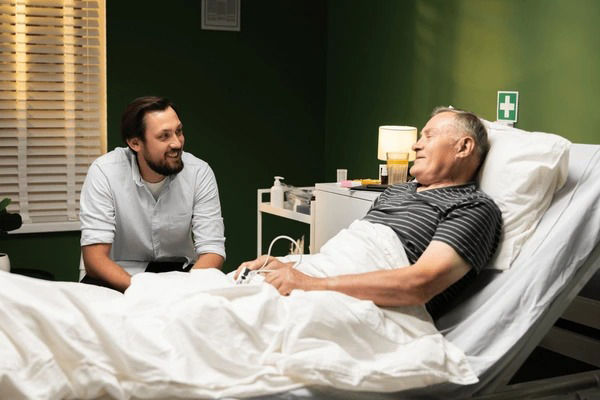
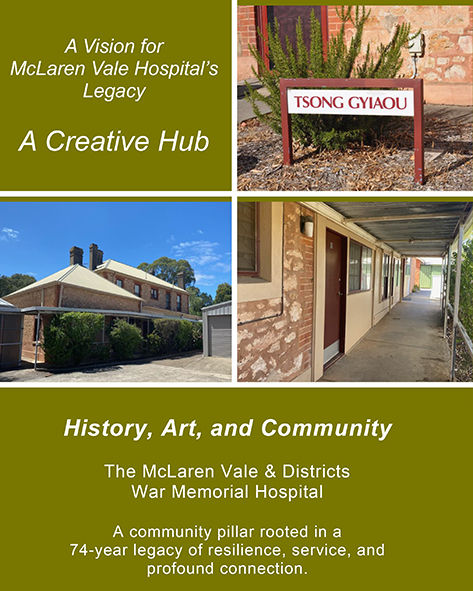
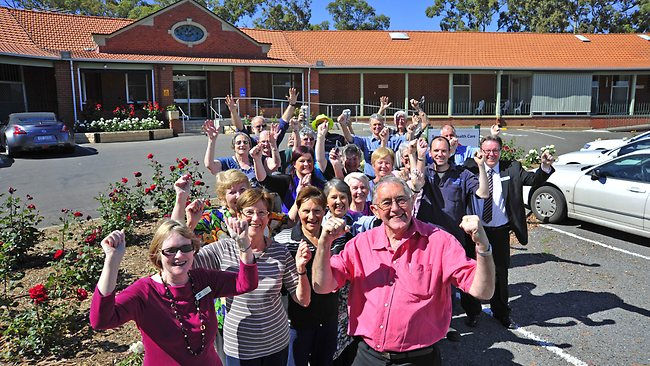
In 2012, the McLaren Vale community faced the imminent closure of their beloved hospital. Rallying with determination, thousands signed petitions and campaigned tirelessly to secure its future. Their efforts paid off when the State Government intervened, safeguarding the hospital's funding and underscoring the power of collective action in preserving essential local services.
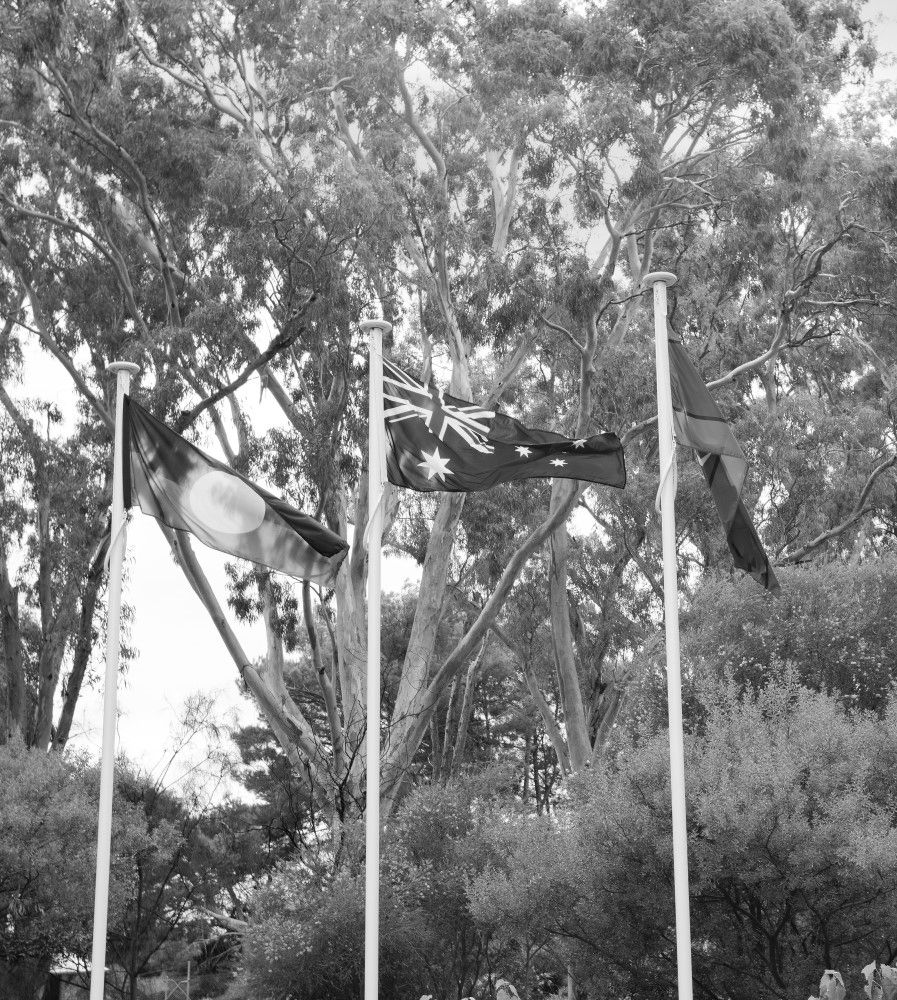
The Heart of a Community
The McLaren Vale & Districts War Memorial Hospital is a testament to its community's resilience, vision, and dedication. Born from spirited debates and unwavering determination, the hospital's story began on September 11, 1945, when residents convened to address the pressing need for quality healthcare in the Southern Districts. This vision took shape to honour those who served and sacrificed in Australia's conflicts, embodying both remembrance and a promise of care.
The journey to build the hospital was no small feat. Overcoming opposition, financial challenges, and the constraints of post-war Australia, the foundation stone, carved from Macclesfield marble and containing a time capsule of local newspapers, was finally laid on 29 April 1950. Less than a year later, on April 28, 1951, Governor Sir Willoughby Norrie officially opened the hospital, heralded by a community parade, a dedication ceremony, and the collective pride of the Southern Districts.
Initially named The Southern Districts War Memorial Hospital, the title reflected its dual purpose: serving the entire region and honouring the memory of those who gave their lives in service. From the outset, it has been a community-driven effort fueled by donations, voluntary labour, and the unyielding commitment of individuals who believed in the power of accessible healthcare.
The hospital has grown and evolved over the decades, adding maternity wings and advanced operating theatres to develop aged care facilities. It has weathered challenges, from debates over viability to the ever-changing healthcare landscape. Yet, its core mission remains steadfast: to provide compassionate and high-quality care to those most in need of it.
Today, under fresh and forward-thinking leadership, the hospital continues to innovate while remaining deeply rooted in its legacy. It exists because generations of people have poured their hearts into making it a reality, and it will thrive only through the continued support, passion, and energy of the community it serves.
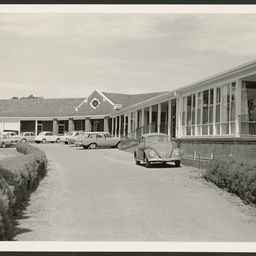
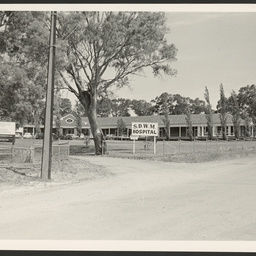


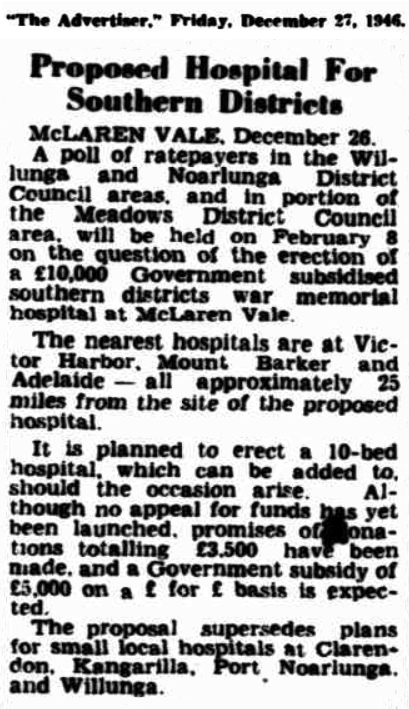
In the Beginning
Inception and Early Efforts (1945)
The vision for the McLaren Vale and Districts War Memorial Hospital emerged during a pivotal community meeting on September 11 1945. Although the need for a hospital in the Southern Districts had been recognised for years, World War II had halted earlier attempts. With the war’s end, local leaders formed a Provisional Committee to explore the feasibility of establishing a centralised healthcare facility, reigniting the community’s determination to turn the dream into reality.
Community Support and Opposition
While the proposal garnered significant local support, it faced opposition, including from a vocal detractor who later conceded his misjudgment. Public meetings across towns like Willunga, Kangarilla, and Port Noarlunga galvanised the region’s residents. The Provisional Committee’s thorough investigation culminated in a report in December 1945, leading to the creation of the Hospital Committee. This group navigated the logistical, financial, and political challenges to bring the project to life.
Progress and Planning (1947)
A landmark moment came on July 31, 1947, when district councils and the Hospital Committee convened to form the first Hospital Board. This newly established board, composed of council representatives and elected members, laid the foundation for organised governance and marked a significant leap toward transforming the hospital from vision to reality.
Site Acquisition and Design Challenges
The hospital’s future found a home when Mrs. Katherine Hall offered her property, including the historic Tsong Gyiaou estate, as the site. Though she passed away before the transaction was completed, her estate honoured her wishes, ensuring the land’s transfer. Financial limitations shaped the hospital’s design, resulting in a modest yet functional 14-bed facility that would later become a cornerstone of regional healthcare.
Construction and Opening (1950–1951)
On April 29, 1950, the community celebrated laying the foundation stone with a grand ceremony featuring a parade, speeches, and festivities. Less than a year later, on April 28, 1951, the hospital officially opened its doors, with Governor Sir Willoughby Norrie presiding over the event. Under the leadership of First Matron, Miss Phyllis Taylor, the hospital began serving patients, fulfilling its mission to provide compassionate care and honouring the legacy of those who served.
A Legacy of Compassion and Dedication
Born in 1901, Dr. Gemmell Tassie began his medical career during the harsh realities of the Great Depression. After graduating in 1926, he practised medicine in the Murray Mallee, where the community of Murrayville faced widespread economic hardship. Often receiving only a fraction of his fees, he accepted payments in farm produce and, in one instance, settled an account worth several pounds for just one shilling.
In 1943, Dr. Tassie relocated to McLaren Vale, where his impact would be transformative. A key figure in establishing the McLaren Vale & Districts War Memorial Hospital, he served as its Medical Superintendent from its opening in 1951 until 1976. Known for his kindness, skill, and unwavering dedication, Dr. Tassie set a standard for general practice that inspired generations of healthcare professionals and solidified his place in the hospital's history.
Dr Gemmel Tassie
.png)
In 2023, the hospital faced another crisis when the Board decided to close the facility, citing financial unviability. This decision ignited community outrage in some sections of the community and triggered a series of legal disputes. Allegations of secrecy, governance failures, and mismanagement culminated in a ruling by the South Australian Supreme Court, which found the Board’s actions to be oppressive and unjust.
Failed Votes and Deepening Division
Two significant membership votes in 2023 complicated the situation. In May, a narrow vote defeated the proposed hospital transfer to The James Brown Memorial Trust (T/A KALYRA), a victory for those fighting to preserve local control. However, in July, a second vote, widely criticised for being influenced by a sudden influx of new members aligned with the Board, reversed the earlier decision. The resulting division deepened tensions within the community and sowed uncertainty about the hospital’s path forward.
Judicial Scrutiny and Courtroom Revelations
A legal challenge was made in the Magistrates’ Court, which was subsequently appealed to the Supreme Court by the hospital board at the time. During these proceedings, Justice Bochner presided over the pivotal under oath testimony of then-Chairman of the Board Chris Overland, who admitted that the hospital was, in fact, solvent and had been operating at a profit at the time the closure decision was made.
Community Resistance and Legal Validation
Prominent community advocates, including Henry Davis, Michael Baragwanath, and Trish Tassie (granddaughter-in-law of Dr. Tassie), spearheaded the opposition to the Board’s plan to transfer the hospital’s assets to aged care provider The court’s decision upheld their claims, affirming that the attempted asset transfer lacked transparency and undermined the community's rightful stake in the hospital’s future.
Future Uncertainty and Community Resilience
Despite the legal victories and persistent public pressure, the hospital’s future remains uncertain. The aftermath of the court ruling saw resignations, new appointments, and continued contention over the institution's direction. Yet through it all, the community has remained resolute. Their unwavering advocacy serves as a powerful reminder of the role community plays in safeguarding local institutions and resisting external forces that threaten their continuity.
